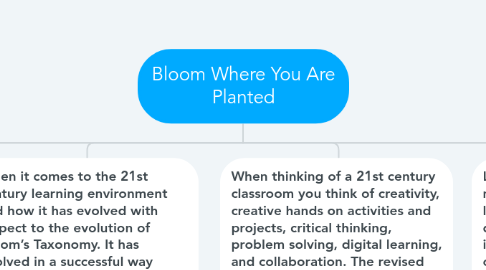Bloom Where You Are Planted
by Cheryl King

1. “Blooms Taxonomy is a hierarchical ordering of cognitive skills that can, among countless other uses, help teachers teach and students learn” (Heick, 2018, para 1). Researchers stated “As teachers, we need to be aware of the level of thought of activities so we can be assured that we are providing a variety of experiences for our students and helping them develop higher levels of thinking. It is important to remember, though, that students can’t just jump to creating complex products and ideas (the highest level) if they haven’t mastered some lower level skills such as remembering and understanding” (Cochran, D. 2015, para2). The evolution of Bloom’s Taxonomy helps the 21st century learning environment in various ways.
2. References Cochran, D. (2015). The New Bloom’s Taxonomy. Retrieved https://www.thecreativeeducator.com/v02/articles/The_New_Blooms Heick, T., (2018). What Is Bloom’s Taxonomy? A Definition for Teachers. Retrieved on June 24, 2019. Retrieved from https://www.teachthought.com/learning/what-is-blooms-taxonomy-a-definition-for-teachers/
3. Digital Tools I can use in the classroom for Bloom’s Taxonomy are Blogs, Voice Threads, Google Sites, Mind Maps, surveys, and online quizzes. The learners will use these tools for various projects to go through Bloom’s Taxonomy stages.
4. Lastly, a 21st century classroom is more of technology and digital learning classroom. Learners can do this and become an independent learner and good critical thinkers and problem solvers through the evolution of Bloom’s Taxonomy.
5. When thinking of a 21st century classroom you think of creativity, creative hands on activities and projects, critical thinking, problem solving, digital learning, and collaboration. The revised Bloom Taxonomy various levels allows 21st century learners to work through the levels of Bloom's Taxonomy.
6. When it comes to the 21st century learning environment and how it has evolved with respect to the evolution of Bloom’s Taxonomy. It has evolved in a successful way because with Bloom’s Taxonomy it includes a higher order of thinking skills. These higher order thinking skills help make for a successful and enriching 21st century learning environment because a 21st century learning environment needs this type of thinking skills for the problem solving skills, creative expressions, technology integration, and collaborative learning.


